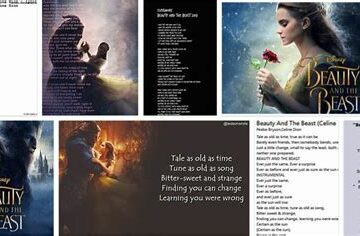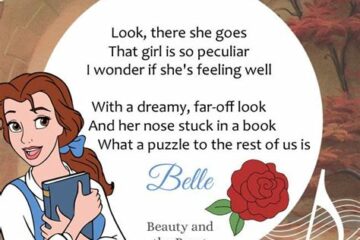The Role Of Music In Enhancing The Story Of Beauty And The Beast

The Role Of Music In Enhancing The Story Of Beauty And The Beast
Understanding The Role Of Music In Narrative Development
In animation and musical storytelling, the role of music is pivotal in guiding the narrative and enriching the overall experience. In The Role of music within the plot of Beauty and the Beast, each musical number serves as a narrative device that propels the story forward, heightens emotional moments, and deepens the audience’s connection to the characters.
Each song functions not merely as an artistic interlude but as a critical enhancement of the storyline. For instance, the opening song, Belle, introduces the audience to the town’s ambiance and the protagonist’s internal struggles. It encapsulates the essence of her character and sets the stage for her journey, effectively weaving music into the very fabric of the narrative.
Moreover, the shift in musical styles and motifs can signify changes in mood or character development. For instance, the transition from light-hearted melodies to more complex and poignant compositions mirrors the progression of the plot, reinforcing plot tension and resolution. As the characters evolve, the music captures their emotional arcs, allowing the audience to feel the weight of their choices and experiences.
As we explore the various musical themes throughout the film, it’s evident that each piece is deliberately placed to guide viewers through the story’s twists and turns, showcasing the indispensable role of music in narrative development. By intertwining music and storytelling, Beauty and the Beast creates a rich tapestry of sound and story that captivates audiences and leaves a lasting impression.
How Music Defines Characters In Beauty And The Beast
In Disney’s Beauty and the Beast, music serves as a vital tool in defining and deepening the characters, helping audiences connect with their journeys and experiences. The transformative power of melody and lyrics not only enriches the narrative but also highlights the complexities of each character.
For instance, Belle’s character is defined through her poignant songs that reflect her longing for adventure and freedom. In Belle, the opening number introduces her as an intelligent and independent woman who feels out of place in her provincial town. The upbeat tempo and vibrant orchestration mirror her optimistic spirit, inviting viewers to root for her quest for self-discovery.
In contrast, the Beast’s character is unveiled through darker, more intense musical themes. His song, Something There, incorporates a sense of turmoil and vulnerability, showcasing his emotional struggle and slow transition from a cursed creature to a more relatable figure. The juxtaposition of Belle’s lighthearted melodies with the Beast’s somber tunes illustrates their contrasting worlds and initial misunderstandings.
Moreover, the antagonistic Gaston’s braggadocio is conveyed through a rousing, boisterous anthem that asserts his dominance and charm. The assertive nature of the music underscores his arrogance, contrasting sharply with the more nuanced emotions expressed by Belle and the Beast.
The role of music in Beauty and the Beast goes beyond mere accompaniment; it is an essential element that shapes characters and enriches the storytelling. The melodies and lyrics chosen for each character offer profound insight into their personas, creating a multi-dimensional experience that resonates with the audience long after the final curtain. Each note and lyric wonderfully encapsulates the essence of the characters, making the music an inseparable part of the narrative fabric.
The Role Of Musical Themes In Emotional Impact
In The Role of music within Beauty and the Beast, musical themes play a crucial part in heightening the emotional landscape of the story. Each song is intricately woven into the narrative, serving to evoke feelings that resonate with both the characters and the audience. For instance, the iconic Tale as Old as Time not only illustrates the romantic development between Belle and the Beast but also acts as a poignant reminder of the themes of love and acceptance.
The use of recurring musical motifs throughout the film helps to establish emotional connections. These motifs often symbolize specific characters or themes, allowing audiences to identify and anticipate emotional shifts within the narrative. For example, the stirring orchestral swell that accompanies moments of vulnerability can evoke empathy, while more upbeat tunes might mirror joy or triumph.
Furthermore, the transition from minor to major keys in various songs signifies character growth and transformation, reinforcing the idea that love and understanding can prevail over adversity. This dynamic use of musical themes effectively enhances the emotional depth of the story, drawing viewers into the tumultuous journey the characters experience.
The strategic placement of musical themes in Beauty and the Beast elevates the overall cinematic experience, emphasizing The Role of music as not just an accompaniment but as a driving force in storytelling. This layered approach to emotion showcases the powerful impact that well-crafted music can have in bringing characters and their stories to life.
Exploring The Role Of Lyrics In Storytelling
The lyrics in Beauty and the Beast serve as a crucial element in enhancing the storytelling experience. They not only convey emotions, but they also provide deeper insights into the characters’ thoughts and motivations. Through careful lyricism, the audience can connect with the characters on a more profound level.
One of the most prominent examples is the song Beauty and the Beast itself, where the lyrics encapsulate the essence of love and transformation. The words highlight the emotional journey of the characters, particularly Belle and the Beast, illustrating their growth and connection. This song serves as a pivotal moment, allowing the audience to feel the weight of their experiences and the evolution of their relationship.
Furthermore, the lyrics often reflect the themes of sacrifice, acceptance, and understanding. By using vivid imagery and relatable emotions, the songs create a memorable narrative that resonates with the audience. For instance, in “Something There,” Belle begins to see the Beast in a new light, and the lyrics articulate her internal conflict and burgeoning feelings. This lyrical exploration adds layers to the storytelling by portraying the complexities of human emotions.
In addition, the use of refrain and repetition in the lyrics emphasizes key messages within the story. By revisiting certain themes through song, the audience is reminded of the core values and lessons that Beauty and the Beast aims to convey. These lyrical elements work in tandem with the musical score to strengthen the overall narrative impact.
The role of lyrics in Beauty and the Beast extends beyond mere words; they are integral to articulating emotions, advancing the plot, and enriching the characters’ narratives. By effectively combining storytelling and music, the lyrics contribute to the timeless appeal and unforgettable experience of this beloved tale.
The Role Of Music In Creating A Memorable Experience
Music has an unparalleled ability to etch moments in our memory, and in Beauty and the Beast, it plays a crucial role in creating a memorable experience for the audience. The enchanting melodies and harmonies not only complement the visual storytelling but also elevate it to an emotional level that resonates long after the final credits roll.
The role of carefully selected musical pieces in the narrative helps to forge a deeper connection between the characters and the viewers. Iconic songs like Beauty and the Beast and Tale as Old as Time are more than just entertaining; they encapsulate the essence of the story, creating poignant experiences that linger in the mind. These musical moments are designed to be unforgettable, often associated with key plot points that define the characters’ journeys.
An essential aspect of this memorable musical experience is the integration of recurring themes. These motifs serve as auditory symbols that link emotions, settings, and character arcs. For instance, different character themes can evoke distinct feelings, allowing the audience to recall specific scenes through sound alone. This technique enriches the storytelling and invites the audience to engage with the narrative on a deeper level.
Moreover, the timing of musical pieces within the flow of the story enhances their impact. By strategically placing songs during pivotal emotional moments, the filmmakers ensure that these experiences resonate more profoundly, solidifying their place in the audience’s memory. The combination of music with visual elements fosters a multisensory experience, reinforcing the connection to the characters and their respective journeys.
The role of music in creating a memorable experience in Beauty and the Beast cannot be overstated. It transcends mere entertainment, becoming an integral part of the storytelling that enhances emotional depth, character development, and audience engagement. The harmonious blend of music and narrative is what makes this beloved tale an enduring classic, ensuring that its magic continues to enchant future generations.
Top 10 Disney Characters You Didn’t Know About
December 30, 2024A Deep Dive Into Disney Princesses And Their Stories
December 29, 2024The Meaning Behind Beauty And Beast Lyrics
December 29, 2024Why Beauty And The Beast Is A Timeless Disney Classic
December 29, 2024The Role Of Disney Princesses In Modern Culture
December 29, 2024Exploring The Themes In Beauty And The Beast Lyrics
December 28, 2024
Leave a reply Cancel reply
Recommended
-
The Evolution of Beauty and the Beast Cartoon Characters
September 26, 2023 -
Belle Songs From Beauty And The Beast Lyrics
August 20, 2023 -
Beauty and the Beast Opening Song Lyrics
October 2, 2021









